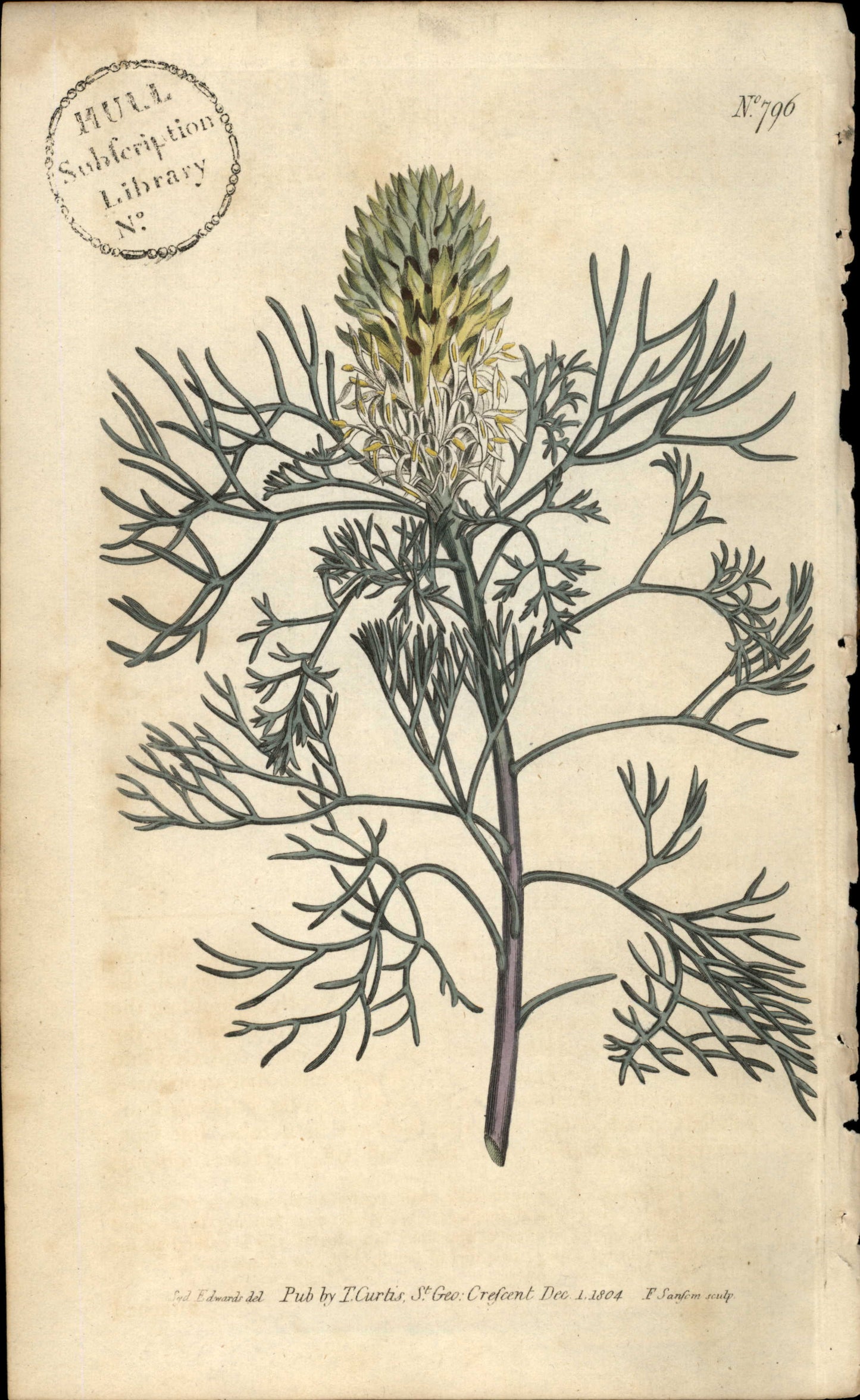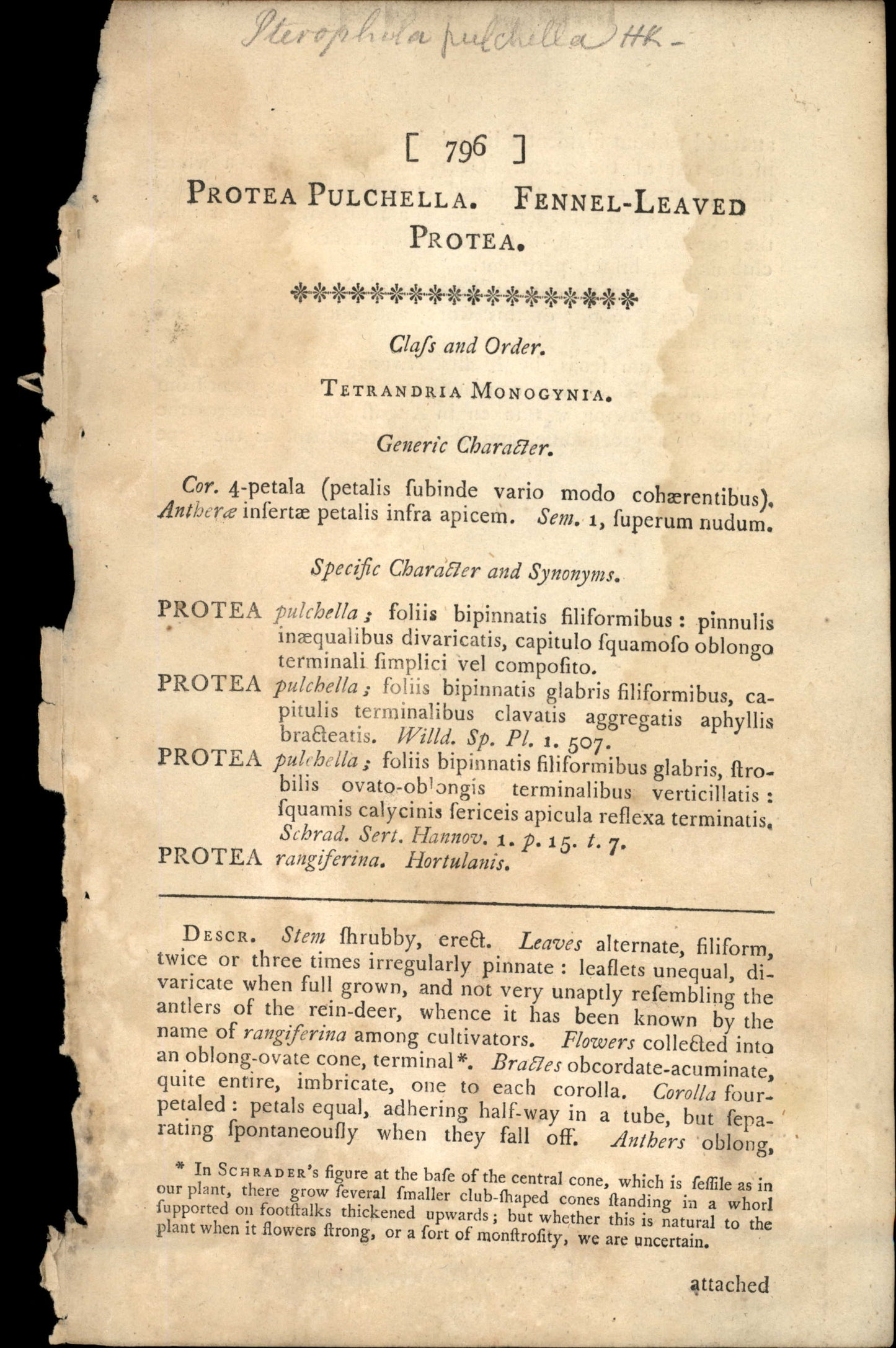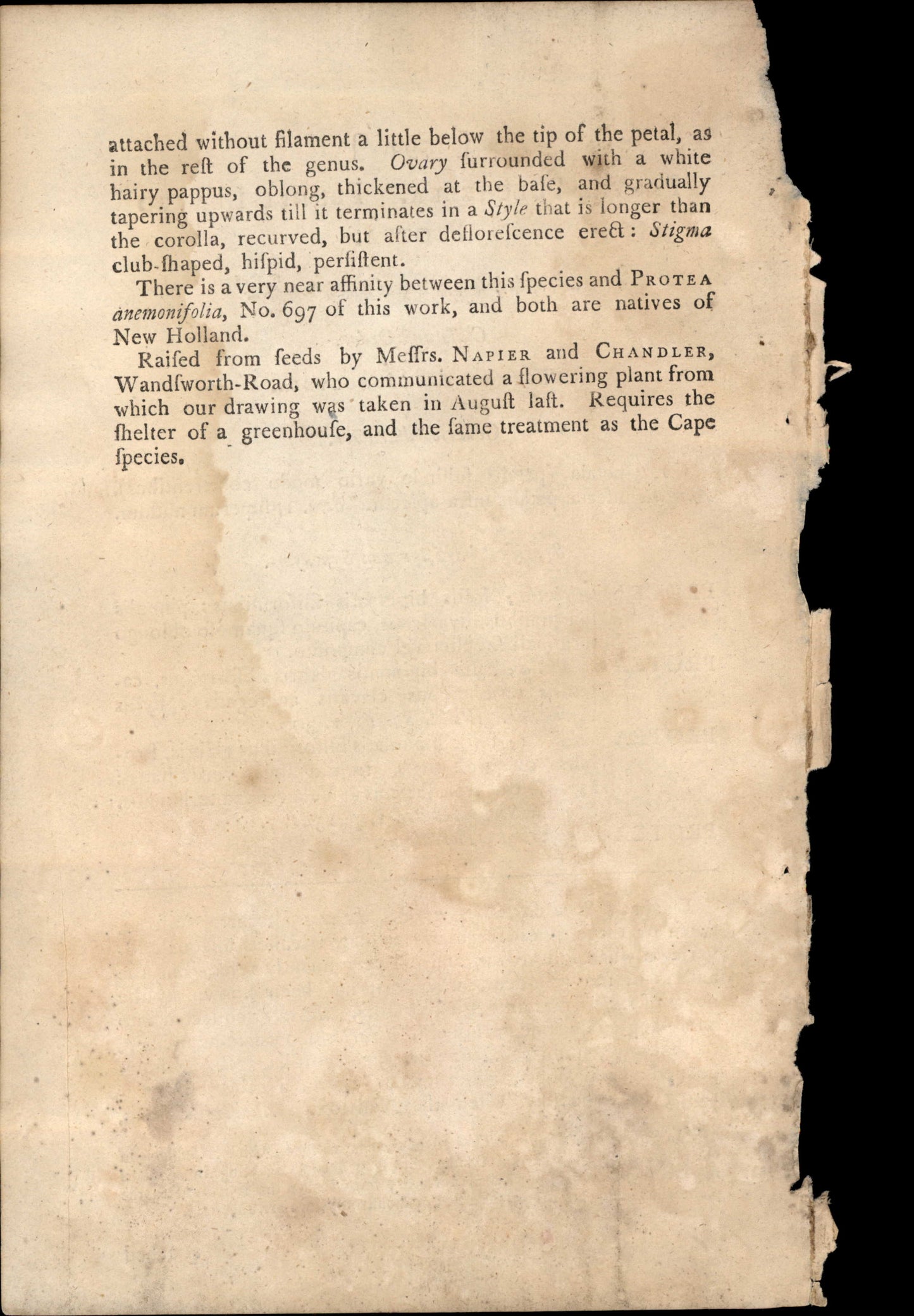Curtis Botanical Magazine
Plate 796 - Protea Pulchella
Plate 796 - Protea Pulchella
Couldn't load pickup availability
Plate 796
Flowering Period: August
Publication Date: Dec 1, 1804
Description:
Complete Botanical Text (Cleaned)
MULL subfcription Library N: syd Edwards del Pub by TCurtis, st Geo: Crefcent Dec. 1.1804 F Sanfem sculp N°796 Iterophila pulchella HR- [ 796] PROTEA PULCHELLA.
FENNEL-LEAVED PROTEA. ********* ** Class and Order. ** TETRANDRIA MONOGYNIA.
Generic Character.
Cor. 4-petala (petalis subinde vario modo cohaerentibus).
Anthera infertæ petalis infra apicem.
Sem. 1, superum nudum. specific Character and synonyms.
PROTEA pulchella; soliis bipinnatis filiformibus: pinnulis inæqualibus divaricatis, capitulo squamoso oblongo terminali fimplici vel compofito.
PROTEA pulchella; soliis bipinnatis glabris filiformibus, ca- pitulis terminalibus clavatis aggregatis aphyllis bractteatis.
Willd. sp.
Pl. 1. 507.
PROTEA pulchella; soliis bipinnatis filiformibus glabris, ftro- bilis ovato-oblongis terminalibus verticillatis : fquamis calycinis fericeis apicula reflexa terminatis. schrad.
Sert.
Hannov. 1. p. 15. t. 7.
PROTEA rangiferina.
Hortulanis.
DEsCR. stem shrubby, erect.
Leaves alternate, filiform, twice or three times irregularly pinnate leaflets unequal, di- varicate when full grown, and not very unaptly refembling the antlers of the rein-deer, whence it has been known by the name of rangiferina among cultivators.
Flowers collected into an oblong-ovate cone, terminal *.
Bradles obcordate-acuminate, quite entire, imbricate, one to each corolla.
Corolla four- petaled: petals equal, adhering half-way in a tube, but fepa- rating spontaneously when they fall off.
Anthers oblong, * In sCHRADER's figure at the base of the central cone, which is sessile as in our plant, there grow several smaller club-shaped cones standing in a whorl supported on sootstalks thickened upwards; but whether this is natural to the plant when it flowers ftrong, or a fort of monftrofity, we are uncertain. attached attached without filament a little below the tip of the petal, as in the reft of the genus.
Ovary furrounded with a white hairy pappus, oblong, thickened at the base, and gradually tapering upwards till it terminates in a style that is longer than the corolla, recurved, but after deflorefcence erect: stigma club-shaped, hifpid, perfiftent.
There is a very near affinity between this species and PROTEA anemonisolia, No. 697 of this work, and both are natives of New Holland.
Raifed from seeds by Meffrs.
NAPIER and CHANDLER, Wandfworth-Road, who communicated a flowering plant from which our drawing was taken in August last.
Requires the shelter of a greenhouse, and the same treatment as the Cape species
Raw OCR Text (Original)
MULL subfcription Library N: syd Edwards del Pub by TCurtis, st Geo: Crefcent Dec. 1.1804 F Sanfem sculp N°796 Iterophila pulchella HR- [ 796] PROTEA PULCHELLA. FENNEL-LEAVED PROTEA. ********* ** Class and Order. ** TETRANDRIA MONOGYNIA. Generic Character. Cor. 4-petala (petalis subinde vario modo cohaerentibus). Anthera infertæ petalis infra apicem. Sem. 1, superum nudum. specific Character and synonyms. PROTEA pulchella; soliis bipinnatis filiformibus: pinnulis inæqualibus divaricatis, capitulo squamoso oblongo terminali fimplici vel compofito. PROTEA pulchella; soliis bipinnatis glabris filiformibus, ca- pitulis terminalibus clavatis aggregatis aphyllis bractteatis. Willd. sp. Pl. 1. 507. PROTEA pulchella; soliis bipinnatis filiformibus glabris, ftro- bilis ovato-oblongis terminalibus verticillatis : fquamis calycinis fericeis apicula reflexa terminatis. schrad. Sert. Hannov. 1. p. 15. t. 7. PROTEA rangiferina. Hortulanis. DEsCR. stem shrubby, erect. Leaves alternate, filiform, twice or three times irregularly pinnate leaflets unequal, di- varicate when full grown, and not very unaptly refembling the antlers of the rein-deer, whence it has been known by the name of rangiferina among cultivators. Flowers collected into an oblong-ovate cone, terminal *. Bradles obcordate-acuminate, quite entire, imbricate, one to each corolla. Corolla four- petaled: petals equal, adhering half-way in a tube, but fepa- rating spontaneously when they fall off. Anthers oblong, * In sCHRADER's figure at the base of the central cone, which is sessile as in our plant, there grow several smaller club-shaped cones standing in a whorl supported on sootstalks thickened upwards; but whether this is natural to the plant when it flowers ftrong, or a fort of monftrofity, we are uncertain. attached attached without filament a little below the tip of the petal, as in the reft of the genus. Ovary furrounded with a white hairy pappus, oblong, thickened at the base, and gradually tapering upwards till it terminates in a style that is longer than the corolla, recurved, but after deflorefcence erect: stigma club-shaped, hifpid, perfiftent. There is a very near affinity between this species and PROTEA anemonisolia, No. 697 of this work, and both are natives of New Holland. Raifed from seeds by Meffrs. NAPIER and CHANDLER, Wandfworth-Road, who communicated a flowering plant from which our drawing was taken in August last. Requires the shelter of a greenhouse, and the same treatment as the Cape species.
Original botanical print from Curtis's Botanical Magazine
Share







